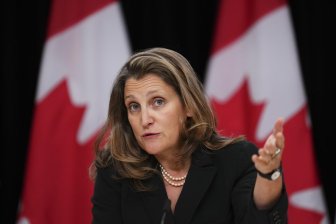A combination of more people moving to the city and a robust energy industry should help Calgary’s economy fare better than the rest of Canada. But persistent pressures and headwinds could create some challenges, according to the latest economic outlook released by the city.

According to the fall Calgary economic outlook, real GDP growth in the Calgary Economic Region (CER) is forecast to be 3.1 per cent this year, better than Alberta’s forecasted 2.9 per cent and Canada’s 1.4 per cent.
Looking ahead, 2024 is expected to see 3.7 per cent real GDP growth in Calgary, compared to Alberta’s 1.9 per cent, and 0.8 per cent expected in Canada and the United States.
Stephen Poloz, former governor of the Bank of Canada and one of the speakers at Wednesday’s announcement, warned against being overconfident with the projections.
“Uncertainty is really hitting us hard right now in many different ways,” he said. “Watch out for the precision that you hear and forecasts, because there’s a lot of things we just don’t know.”

Premier Smith delivers Alberta state of the province speech to Edmonton business crowd
He said there are forces not being accounted for in models, like the impacts of artificial intelligence and increasing numbers of retirements in Baby Boomers, that could emerge as important factors in global and local economies.
Poloz said the province’s energy industries can help provide a bit of insurance against global economic headwinds, with Canada and other countries showing evidence of a technical recession, and will likely weather the coming years better than the rest of the nation.
“It doesn’t mean necessarily a boom time, but it means that you’ve got an insulator in this situation,” he said.
“However, if the global recession becomes a real one, then we could see the other side of that cycle. And then, of course, that would mean a place like Alberta gets it twice: they get the slowdown and commodities fall at the same time.
“So that’s why you just can’t be overconfident about all this.”
The city’s report said crude oil exports should continue to grow through to 2028, “while at a decelerated pace compared to the rapid growth in the past two years.”
“With Trans Mountain pipeline expansion completion delayed to the second quarter of 2024, the price differential between the Western Canadian Select (WCS) and WTI should continue to exist in the near term before improving with increased transportation capacity,” the outlook reads.

‘Renewables are being used as a negotiating tool’: Alberta clean energy producers respond to regulation squabbles
It notes the USD-CAD exchange rate should average USD$0.76 per Canadian dollar in the same time range, which should translate into steady cashflows for businesses in and around oil and gas.
But achieving net-zero scenarios will require the industry to “significantly reduce” emissions and “restructure its end-use energy sources.”
Mark Parsons, ATB chief economist, expected energy to help insulate the province’s economy, but also expects it to be hit by the same headwinds.
Parsons also said the last eight years have been a “difficult adjustment” to the economy.
“What it means is we’re seeing pockets of growth in other sectors,” he said. “We’re seeing more signs of diversification than we have in a while. But it’s been a difficult adjustment. Getting there has been hard.”

Alberta reaction to federal bill aimed at helping workers transition to clean-energy economy
Brad Parry, president and CEO of Calgary Economic Development, acknowledged there may be tough times ahead, but the city’s economy is in a “pretty OK spot” compared to other jurisdictions.
“At the end of the day, I think we’re well-positioned to take advantage of the opportunities that might present themselves,” Parry said.
“The key takeaway from the fall outlook is that growth in the Calgary Economic Region in 2023 is expected to outpace the rest of Canada, as relative housing affordability and lower living costs drive interprovincial migration and attract a sizeable share of international immigrants to our city”, said Carla Male, the city’s chief financial officer, in a statement.
“Accompanying this record-setting increase in population will be a greater demand for housing, infrastructure, and public services.”
The population surge is expected to support consumption, fill job vacancies and continue putting demand on housing. But the city doesn’t expect the surge to last, with a deceleration expected in 2024.
Employment growth and real wage increases are expected to boost earnings and consumer spending this year, but elevated inflation and interest rates, and increased household indebtedness is expected to dampen consumer spending next year.

City and province to study feasibility of train to Calgary airport
Inflation is expected to “moderate” to 3.9 per cent this year. But the economic outlook highlighted a few sticking points in inflation: demand outpacing supply in consumer goods and services, a tight housing market, and stubborn core inflation due to tight labour markets and robust consumer demand.
Housing prices are expected to increase by 1.9 per cent in 2023, and purpose-built rental apartment construction increased “solidly” this year in response to the population surge.
Mayor Jyoti Gondek said she would like to see more supports from other orders of government for efforts like the 10-year downtown revitalization plan that is seeing early successes.
With budget deliberations coming later this month, Gondek said city council’s decisions show the commitment to “future-proofing” Calgary.
More on Calgary
“Our ability to survive as a municipal government is rooted almost solely in property tax revenue, so our investment into downtown is critical because we’re hoping that we’re going to be able to increase our assessment base, which drives our revenue stream,” Gondek said. “So we are taking care of ourselves as best we can.”
And the average unemployment rate is expected to stay above six per cent before trending down in 2025, as job growth is expected to only slightly exceed the increase in the labour force.
The high cost of borrowing and construction is expected to hold back business investment in the coming year.
Transportation and warehousing, and utility companies are expected to have the greatest decrease in capital investments. But the manufacturing sector and professional, scientific and technical services are expected to see “solid growth” through 2023, with the latter services’ growth coming from demand from the energy and tech sectors.
Calgary’s economy expected to fare better than rest of Canada, with some headwinds - Global News
Read More


No comments:
Post a Comment